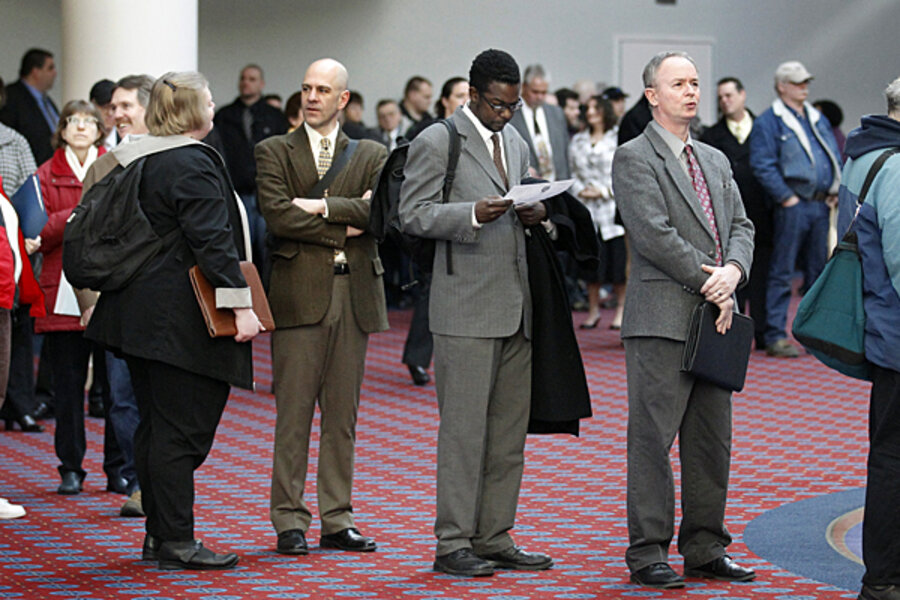Economy adds 120,000 jobs. Why the dip from bigger gains in early 2012?
Loading...
| New York
Job creation slowed in March, the Labor Department said Friday in a report that was disappointing to the markets.
According to the government, the economy added only 120,000 jobs after much larger gains in January and February. The unemployment rate fell from 8.3 percent to 8.2 percent.
Economists had been expecting higher numbers of new jobs – between 200,000 and 300,000. But now, they think the relatively balmy weather in January and February prompted many employers to start their spring hiring earlier. At the same time, the economy – especially retailers – may be hitting some head winds as a result of gasoline prices that are approaching $4 a gallon.
Economists cautioned that a month’s slowdown in hiring does not indicate the economy is collapsing. But there is little doubt that the less-than-robust hiring opens the door for Republicans to hammer President Obama on his handling of the economy. A slower rate of job growth may also force the Federal Reserve to weigh yet another round of monetary stimulus. And the stock market, which has been rising, may reconsider whether it has been overly optimistic.
“This is not really a bad report,” says Robert Brusca of FAO Economics in New York. “But the question we can’t answer is whether the period of job growth is over, or is this just a one-month event.”
Viewed over the past three months, job growth is relatively strong. In the first quarter of the year, according to the Department of Labor, payroll employment rose by an average of 246,000 per month. In March, the main job gains were in manufacturing, food services, and health care. And in a trend that may help the economy, the government sector appears to have stopped shedding jobs. Retailing, however, lost jobs.
Although the stock market was closed for Good Friday, the futures markets reacted badly to the jobs numbers: The Standard & Poor’s futures index was off 1.2 percent at about 10 a.m. The bond market, which was open for a half day, saw yields fall, with the 10-year Treasury bond dropping to 2.07 percent.
The low yield in the bond market reflects some traders’ view that the Federal Reserve may begin another round of what it terms quantitative easing, says Scott Brown, chief economist at Raymond James & Associates in St. Petersburg, Fla. “It’s not likely, but it’s back on the table,” he says.
Barclays Capital economist Michael Gapen, in an analysis, writes that the soft jobs numbers “certainly leave the door open for further accommodation and may shift the decision point” to June, when the Fed’s policymakers meet.
Almost as soon as the jobs report was issued, Republicans were issuing their press releases. In a statement, House Speaker John Boehner said, “Today’s report shows that families and small businesses are still struggling to get by because of President Obama’s failed economic policies.”
The White House tried to put a more positive spin on the numbers. Alan Krueger, chairman of the Council of Economic Advisers, in a statement said, “There is more work to be done, but today’s employment report provides further evidence that the economy is continuing to recover from the worst economic downturn since the Great Depression.”
Mr. Obama, addressing on Friday a White House Forum on Women and the Economy, mainly focused on longer-term issues facing female employment, such as equality of pay and the paucity of women at the upper levels of corporations.
Over the past three months, one of the strongest sectors overall has been manufacturing. This continued in March with the sector adding 37,000 jobs. The gains in manufacturing have been led by companies related to the auto industry, says Dan Meckstroth, chief economist at Manufacturers Alliance for Productivity and Innovation (MAPI) in Arlington, Va. In large part, this reflects Americans trading in their gas-guzzling clunkers for newer, more fuel-efficient vehicles.
“Manufacturing is still recovering,” says Mr. Meckstroth. “Since the end of the recession, we have now added back 426,000 of the 2.28 million jobs lost, or about 20 percent.” The general economy, by comparison, has regained 3.5 million jobs out of the 8.66 million jobs lost.
“There seems to be a more optimistic outlook about the manufacturing sector,” he says.
Despite the slowdown in hiring in March, some economists are becoming more optimistic about the economy, especially from mid-2013 to mid-2014. One of those is Mark Zandi, chief economist at Moody’s Analytics, who, in an analysis released this week, expects the economy to grow at a 4 percent annual rate during that time.
He also expects unemployment to fall more quickly this year and next year. And he projects that the unemployment rate will be 7 percent by the end of 2013. By the end of 2015, he forecasts, it will fall to under 6 percent, which the Federal Reserve considers full employment.







